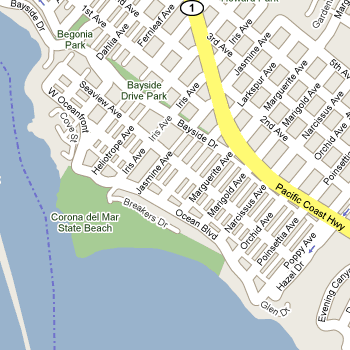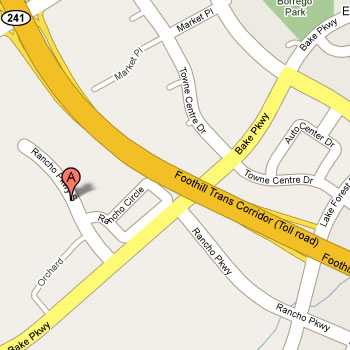FREE GROUP WORKOUTS (Week of July 27th)
All of our group workouts are free to all members and non-members, so come on out!
We want everyone to enjoy our group workouts but we should clarify the intent. The intent of the group workouts is to “workout.” Yes, it includes a social element. Yes, your Triathica host is happy to give you tips. But please be aware that everyone there is attempting to get a workout in at his or her own pace. If we all go at the slowest person’s pace many people won’t be getting in a proper workout. We will attempt to pair you up with another athlete so you’re not left alone.
Week of July 27th
Event: Group Swim
Place: Triathica flag at Big Corona near the lifeguard station next to the jetty (Regular Location)
Day: Wednesday, July 29th
Time: 5:30 p.m.
Planned Workout: 1 – 3 loops around the buoys
Event: Group Ride
Place: Triathica HQ
Day: Saturday, August 1st
Time: 7:30 a.m.
Planned Workout: 1 loop around Santiago Canyon
Event: Group Run
Place: Triathica HQ
Day: Sunday, August 2nd
Time: 7:00 a.m.
Planned Workout: 9 miles through Whiting Ranch
PETE & CORRINNE UPDATE #4
Kelli Whittaker
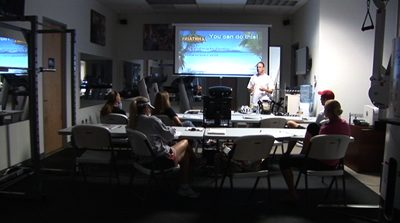 Corrinne and Pete have had another busy week training. They both attended the 12-week training camp seminar last Saturday on triathlon rules and safety and really enjoyed themselves. Corrinne is already excited over the progress she has made stating, “I really think this camp is going to give me an advantage in my future races.” She also couldn’t believe that people actually die from triathlons every year because they are not prepared. 1.5 out of every 100,000 die yearly on average during a triathlon event. This really shows you how important it is to properly prepare yourself before a race and that safety should always come first!
Corrinne and Pete have had another busy week training. They both attended the 12-week training camp seminar last Saturday on triathlon rules and safety and really enjoyed themselves. Corrinne is already excited over the progress she has made stating, “I really think this camp is going to give me an advantage in my future races.” She also couldn’t believe that people actually die from triathlons every year because they are not prepared. 1.5 out of every 100,000 die yearly on average during a triathlon event. This really shows you how important it is to properly prepare yourself before a race and that safety should always come first!
They went back to the Orange County International Triathlon bike and run course and repeated the workout they had done the prior week. Corrinne was stunned when she shaved ten minutes off her bike time. She said, “knowing the course makes a huge difference. It gave me more confidence and I believe the confidence really helped.” According to Pete, “this time around the course was much easier for me. I knew what to expect and that gave me more confidence. Overall it was a very encouraging workout for both of us.”
Pete and Corrinne are now both being sponsored by Hammer Nutrition. Hammer Nutrition is providing them with some of their products and with nutrition plans for the 12-weeks of the training camp. Pete says, “having the protein powder, nutrition bars and all of the other products Hammer provides has really helped me. I feel like the combination of their products and my hard work will take me to the next level and I’m very thankful to Hammer for their support”. Corrinne also stated, “having Hammer products at my disposal has made my life so much easier. Instead of scrambling to find some sort of supplement to re-fuel my body after an intense workout I can use the Hammer products that they have provided to regenerate my body.”
Tune in next week to see how Pete and Corrinne are doing!
THE DAILY 10
Kelli Whittaker
As an athlete the way you treat your body can have a huge impact on the way you perform. Everyone is different, but the basics of good nutrition are consistent across the board. However, in today’s society sticking to those basics without going overboard one way or the other is easier said than done.
To make it easy there are 10 easy tips that you can use daily to keep your body in optimal condition.
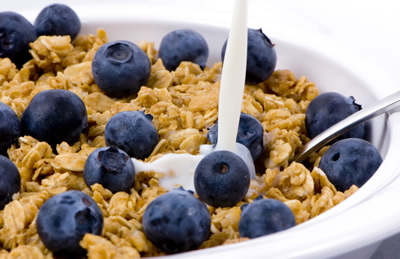 1. Eat Breakfast. Breakfast, first and foremost, kick starts your metabolism, but it will also makes you feel better and it will help with appetite control as the day progresses.
1. Eat Breakfast. Breakfast, first and foremost, kick starts your metabolism, but it will also makes you feel better and it will help with appetite control as the day progresses.
2. Eat five or more meals a day. Stop thinking of your eating habits as a breakfast, lunch, and dinner ordeal only. It is recommended that you eat five small meals throughout the day. Eating these small meals throughout the day will keep your energy levels high and your appetite at bay. If you wait too long in between meals the chance of you overeating at your next meal drastically increases.
3. When creating meals remember the 1-2-3 rule. Within the five meals you eat daily one part should be from fat, two parts should be from protein, and three parts should come from carbohydrates. Whenever you eat a carbohydrate make sure that you also eat a protein.
4. Drink plenty of water. Water is a key ingredient to any athletes’ success. It is recommended that you drink eight to 10 glasses of water a day. This will ensure that you are replacing the fluids you lose during exercise. Drink this throughout the day not all at once, and never wait until you’re thirsty. If you’re thirsty your body is already depleted.
5. When making food choices remember not all protein, carbohydrates, and fats are equal. We all know that there is a difference between candy verses whole-wheat toast and chicken verses a fatty beef. Choose wisely and remember “moderation.” You can eat the fatty meats and candy, but don’t go overboard remember be smart and really look at what you are eating before making food choices. Try to make the best choice for your body’s health.
6. No fad diets. Fad diets don’t work for the long-haul and they are extremely unhealthy. If fat loss/weight loss is needed, implement proper diet and exercise. It may take longer, but it will be better for your body and the chance of the change lasting is much higher.
7. Multivitamins. Take a multivitamin daily. Especially as an athlete, it is important to have the right balance of nutrients in your body. This will ensure optimal performance. A basic multivitamin is a good insurance policy for athletes.
8. Recovery meals. Replenish your energy level with post-exercise recovery meals. Most post exercise carbohydrates should be complex with a low glycemic index.
9. Wise food choices. Try to stay away from fried, caned or processed foods. Don’t deprive yourself from what you are craving, but don’t go overboard either. Try to eliminate processed sugars because they have no nutritional value.
10. Stop eating late at night. If you eat past 8:00 p.m. your body will not have enough time to properly digest the food before you go to sleep. This just leaves the food to sit in the stomach and slows down the digestion process. Avoiding this will not only make you feel better it will probably also help you lose a couple of pounds.
Follow these simple 10 rules and you’ll be well on your way to a healthier body. Best of luck!
YOUR TRAINING ZONES
Ron Saetermoe
Have you ever wondered what your training zones are? Have you ever wondered why they’re important? Allow me to explain . . .
Your training zones (TZ) are various levels of training intensity you workout at. The harder your effort, the higher the training zone. At Triathica we use a 10-point scale, which is a modified version of the Borg scale, which measures your Rating of Perceived Exertion (RPE).
RPE is essentially how you’re feeling given the current stress your body is under. This of course is a subjective thing but can be a pretty accurate predictor of your TZ.
|
% Max Heart Rate |
Training Zones
|
Rating of Perceived Exertion
|
Feels Like…
|
|
50% – 55%
|
1-low
|
1
|
Nothing!
|
|
55% – 60%
|
1-high
|
2
|
Next to nothing!
|
|
60% – 65%
|
2-low
|
3
|
Something!
|
|
65% – 70%
|
2-high
|
4
|
I’m perspiring!
|
|
70% – 75%
|
3-low
|
5
|
I’m sweating!
|
|
75% – 80%
|
3-high
|
6
|
Work!
|
|
80% – 85%
|
4-low
|
7
|
Really hard work!
|
|
85% – 90%
|
4-high
|
8
|
I’m going to puke!
|
|
90% – 95%
|
5-low
|
9
|
I can’t breath!
|
|
95% – 100%
|
5-high
|
10
|
Death!
|
You can see by the table above that each training zone has a corresponding RPE. We use this scale when testing our athletes and establishing their TZ.

It is also important to note that you will probably have different training zones for each event. Typically, the swim has the lowest followed by the bike with the run having the highest range. This is probably due to the fact that your entire body weight is supported while in the water and the bike supports much of your weight as well. When you run, it’s all you baby!
The reason why it’s important to understand your training zones is to help structure your training properly and note your progress.
Ideally, your training will include periods of “test” and “rest.” The “test” is hard training that intends to stretch your limits. The periods of “rest” allow your body to heal and absorb your training so you’ll be more fit next time. If you structure your workouts so you’re testing and resting your body, your workouts will have more of an impact.
The other reason to be aware of your TZ is to note your progress. We call these milestones “marker sets.” If you note your heart rate for the same workout at different times (say nine weeks later) you will hopefully see an improvement. Generally we note the improvement in terms of a lower heart rate for the same effort (swim pace, watts on the bike or run pace).
To establish your training zones we use three separate testing protocols (swim, bike, run). Essentially we give you an opportunity to warm up – then we beat the crap out of you until you tell us to stop!
We use a “graded” testing protocol to determine your maximum heart rate. In other words, the effort becomes greater and greater until you can’t take it any longer. We’ll ask you throughout the test what your RPE is. We’ll ask you one last time after you’ve stopped and calculate your maximum heart rate from there.
The old method of determining maximum heart rate established by Drs. Fox and Haskell has never worked. For example, if I used this chart I would predict my maximum heart rate to be: 220 minus 53 (my age) = 167. I’ve had my maximum heart rate tested several times and it’s more like 200. So much for formulas!
If you’re interested in knowing what your TZ are this is the perfect time to do so. Triathica has a membership special of $40.00 per month and you get all three TZ assessments for free. Keep in mind that we don’t have ANY initiation fees or contracts so the worst case is that you get three assessments worth $150.00 for $40.00.
Call us to schedule yours. 949.273.6223
IRONMAN NUTRITION
Larry (Lar-Dog) Davidson
Lar-Dog, a member of Triathica, and a good friend, recently enlightened us with some of his Ironman nutrition secrets.
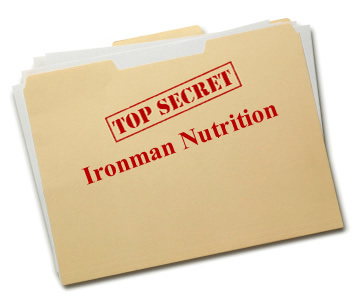
According to Davidson, “It’s no secret, really. I simply use Infinit Nutrition’s Ironman formula with a few minor modifications (a calorie and caffeine boost). Inifinit’s regular Ironman formula contains 280 calories but I mix it to three times the normal strength in a 20-ounce bottle. I stir it with a knife or straw to help keep the foaming to a minimum (the protein causes it to foam-up if shaken) and I’m ready to rock!”
While on the bike, Davidson, sips the Infinit blend and chases it down with water from his aero bottle. At aid stations he replenishes the water in the aero bottle and keeps on cranking. He has another bottle waiting for him in his special needs bag and he’s got another 840 calories to help him complete the 112 grueling miles.
In addition, he’ll keep his Gu bottle, caffeine pills and salt tablets handy in the event he needs them. According to Infinit all of your nutrition needs for your endurance event can be satisfied with the Ironman formula – nothing else is needed, other than water.
On the run Davidson takes a Gu early on because as the race wears on it becomes harder to eat solid food. He alternates Coke, Gatorade Endurance and water between the aid stations on the run and takes lots of salt to avoid cramping.
Take it from one of the strongest age group Ironmen, Lar-Dog Larry Davidson if you’re looking for the elusive secrets to an Ironman PR.


